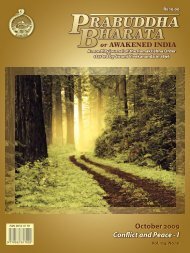P
PB Cover July 2011.indd - Advaita Ashrama
PB Cover July 2011.indd - Advaita Ashrama
- No tags were found...
Create successful ePaper yourself
Turn your PDF publications into a flip-book with our unique Google optimized e-Paper software.
Sri Ramakrishna: The ‘New Man’ of the Age – III 49<br />
and the modern. As mentioned earlier these five<br />
types of harmony were not merely a matter of<br />
toleration and social accommodation. They were<br />
derived from a true vision and understanding<br />
of Reality and were based on two fundamental<br />
principles that Sri Ramakrishna seemed to have<br />
followed in his life.<br />
The first principle is unity in diversity. Sri<br />
Ramakrishna had realized that underpinning all<br />
the diversity of the phenomenal world there is the<br />
substratum of infinite, unchanging, unbroken,<br />
non-dual consciousness. All the diversities finally<br />
lead to a basic unity. Having established himself in<br />
the basic unitary consciousness, Sri Ramakrishna<br />
could see harmony in all forms of diversity.<br />
The second principle is of acceptance. Sri<br />
Ramakrishna accepted diversity as a part of the<br />
divine plan. It should be noted that Sri Ramakrishna<br />
did not try to find the common ground<br />
among religions or among the sects of Hinduism,<br />
nor did he try to ‘harmonize’ religions<br />
or sects. He simply accepted all religions and<br />
sects as they are, with all their differences. He<br />
did not try to iron out or reconcile those differences.<br />
He just accepted them as the unique<br />
features of religions and sects.<br />
Conflicts and quarrels arise only when<br />
people refuse to accept diversity—diversity of<br />
religions, diversity of sects, diversity of human<br />
temperaments, and so forth. Conflicts and<br />
quarrels arise when people take the stand that<br />
their religion alone is true and all other religions<br />
are false, that is, they are not religions at<br />
all. They claim that they believe in an omniscient<br />
and omnipotent God but, at the same time,<br />
they refuse to see that God himself must have<br />
created diverse religions and that diversity is a<br />
part of God’s plan of the world.<br />
Sri Ramakrishna accepted religions and sects<br />
as they are. Where others saw conflicts, he saw<br />
harmony; where others saw error and falsehood,<br />
PB July 2011<br />
he saw truth and reality. To establish harmony<br />
among religions it is not necessary to formulate<br />
any big theories. All that is needed is to simply<br />
allow people to follow their own religions or<br />
sects without disturbing others. Religious conflicts<br />
arise when religious leaders with their<br />
narrow views and ignorance of other religions<br />
spread dogmatism and fanaticism among common<br />
people. In recent years religion has come<br />
to be associated with politics in many countries,<br />
especially in India. This has aggravated religious<br />
conflicts and made religion one of the chief<br />
causes of social violence and unrest. Regarding<br />
this Swami Vivekananda says: ‘Now, in my little<br />
experience I have collected this knowledge—<br />
that for all the devilry that religion is blamed<br />
with, religion is not at all in fault: no religion<br />
ever persecuted men, no religion ever burnt<br />
witches, no religion ever did any of these things.<br />
What then incited people to do these things?<br />
Politics, but never religion; and if such politics<br />
takes the name of religion whose fault is that? ’ 15<br />
There are, however, signs that the situation is<br />
changing fast. The Internet is bringing people all<br />
over the world closer to one another. Through the<br />
Internet people are coming to know about other<br />
religions and are able to appreciate the good points<br />
in them. They are learning to think for themselves<br />
independent of the influence of religious leaders.<br />
Harmony of religions is no longer a matter to be<br />
decided by religious leaders. It is being taken up<br />
and practised by the common people. The ideas<br />
of harmony that Sri Ramakrishna lived and taught<br />
are now practised more and more by people in<br />
many countries, although many of them may not<br />
know about Sri Ramakrishna or his message of<br />
universal harmony.<br />
P<br />
References and Notes<br />
14. Gospel, 155.<br />
15. Complete Works of Swami Vivekananda, 4.125.<br />
509
















